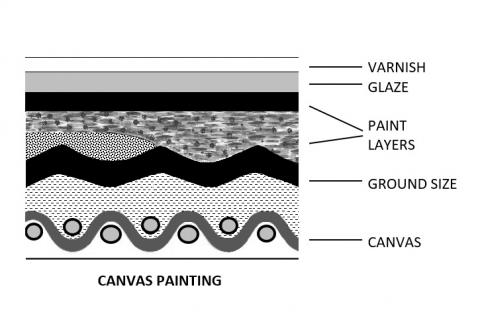Paintings
D. Gilroy, I. M. Godfrey and I. Loo
Introduction
Ancient cave and rock paintings provide evidence of the lifestyles and relationships between prehistoric people and their environments. These earliest of works, as with modern paintings, vary greatly in their subject matter, style, techniques and use of materials.
Paintings most often conjure images of framed pictures using oils, watercolours or acrylic on canvas, paper or wood panels. While watercolours will be referred to occasionally in this chapter, as much of the conservation focus for watercolours relates to the paper support, readers are directed to the Paper and Books chapter for further information about the care of these materials. The care and conservation of frescos and murals is also not covered in this chapter. The term ‘paintings’, for the purpose of this chapter therefore, will refer primarily to works on canvas, wooden panel and boards with media ranging from oils and egg tempera to synthetics. There are of course, a great many types of supports as well as finishes and materials. If we consider some of these materials it is obvious that the traditional term needs to be viewed in a broader context. Inks, chalks, acrylics, pastels, charcoal and other materials, either alone or in combination, together with a variety of grounds or varnishes may all be applied to a variety of supports. The addition of other materials, as in collage or ethnographic material, further blurs the boundary between painting and object.
Structure
Paintings (easel paintings in particular), usually comprise the following elements (Figure 1):
- a support, predominantly a textile canvas, but may be composed of other materials such as wood, metal, ivory, bone, leather, glass or stone;
- an auxiliary support such a stretcher or a strainer to keep the painting taut. Keys, usually flat triangular wooden or plastic wedges, are used in the corners to adjust the tension of the fabric and to maintain a smooth appearance;
- a size, such as animal glue, is used on a canvas to fill pores, isolate coatings or to make surfaces suitable to receive coatings (Mayer 1991);
- a ground, such as gesso or pigments mixed with oil, usually to produce a white background, uniform texture, degree of absorbency, as well as an intermediate structural layer between the support and acidic painting layers;
- a paint layer composed of pigments (either organic or inorganic) and binders such as oils, egg tempera, gums, wax, or synthetic polymers and resins; and
- a varnish layer, applied to the surface of an artwork that may be either a natural resin like dammar, mastic or shellac or a synthetic resin such as alkyds, acrylics or ketones. Many acrylic paintings are not varnished.
Figure 1: A cross-section showing the structure of an easel painting.
Added to the above could be other material such as feathers, sand and wood, all of which react differently to the agents of deterioration.













